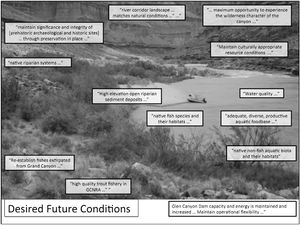Portal:Desired Future Conditions -DFCs
|
|
The following Desired Future Conditions (DFCs) are intended to be used within the Adaptive Management Program (AMP), including by the Adaptive Management Work Group (AMWG), to help guide the development of recommendations concerning management of Glen Canyon Dam operations and related activities, and dam impacts on Grand Canyon National Park (Grand Canyon) and Glen Canyon National Recreation Area (Glen Canyon). The focus of this document is to identify DFCs that can be accomplished through dam operations. However, for the sake of completeness, this document also includes DFCs that might be achieved through non-operational measures. |
| Justification The Secretary is authorized to consider and implement both operational and non-operational measures to address downstream effects of Glen Canyon Dam if those measures meet the Grand Canyon Protection Act’s goal of protecting, mitigating adverse impacts to, and improving the resources downstream of the dam (see Section 1802 of the Grand Canyon Protection Act) |
Scope of the DFCs The Colorado River ecosystem (CRE) which is defined as the Colorado River mainstream corridor and interacting resources in associated riparian and terrace zones, located primarily from the fore bay of Glen Canyon Dam to the western boundary of Grand Canyon National Park. It includes the area where the dam operations impact physical, biological, recreational, cultural, and other resources. The scope of GCDAMP activities may include limited investigations into some tributaries (e.g. the Little Colorado and Paria Rivers). |
DFC Organization These DFCs are divided into four categories, including the Colorado River Ecosystem, Power, Cultural Resources, and Recreation. There are many direct and indirect, short-term and long-term ecosystem responses to dam existence and operations. These DFCs are directly or indirectly linked on short and long-term bases through dam-related flows, sediment retention and distribution, hydropower production, fish and wildlife populations, recreation, and visitor experience. |
|---|
"Before the Adaptive Management Program can measure its success, it must first develop a clear statement of what it is trying to accomplish."
"You can't control what you can't measure."
|
|

